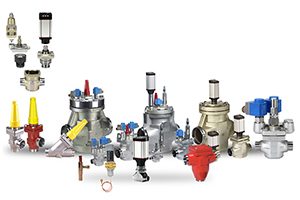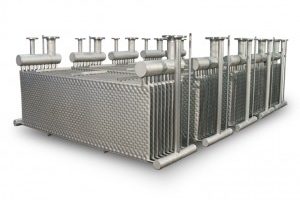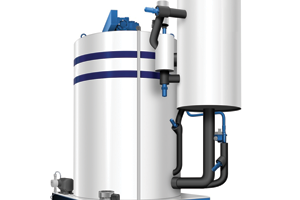What is a Cube Ice Maker and What is it Used For?
A cube ice maker is a machine that produces ice in uniform, transparent cubes. This type of ice is ideal for beverages and food applications in restaurants, cafés, hotels, hospitals, and even residential use due to its clean appearance, long-lasting shape, and slow melting rate.
Advantages and Disadvantages of Industrial Cube Ice Makers
Industrial cube ice makers have become increasingly popular in the food, restaurant, and even medical industries due to their precise performance and the uniform appearance of the ice they produce. However, like any specialized equipment, these systems have their own strengths and limitations, which are discussed below.
Advantages of Industrial Cube Ice Makers
When properly selected and installed, an industrial cube ice maker can offer the following benefits:
- Production of clear, hygienic, and high‑quality ice: The ice cubes are typically bubble‑free, odorless, and safe for consumption.
- Optimized energy and water usage: Modern models are designed to produce ice only when needed, minimizing water and electricity consumption.
- Compact and low‑noise design: Ideal for semi‑industrial spaces, cafés, and commercial kitchens with noise or space limitations.
- Fully automatic operation: The machine connects directly to the water supply and produces ice continuously with minimal user intervention.
Disadvantages of Industrial Cube Ice Makers
Despite their many benefits, it is important to consider the following limitations before purchasing:
- Relatively high initial cost: High‑capacity models can be a significant investment for some businesses.
- Water filtration required: In areas with hard water, proper filtration is necessary to maintain ice quality and prolong the unit’s lifespan.
- Regular maintenance needed: Stable operation requires periodic cleaning of the evaporator, filter replacement, and routine compressor inspection.
Types of Cube Ice Makers by Capacity and Application
Cube ice makers are designed and manufactured in various models based on production capacity and usage. Understanding these categories helps in making a smarter and more cost‑effective choice. Below are the most common types of cube ice makers categorized by capacity and application:
- Small Cube Ice Makers (Low Capacity)
These units typically produce 50 to 80 kg of ice per day and are suitable for offices, small shops, pharmacies, and commercial spaces with limited demand. Their main features include compact size, easy installation, and low energy consumption. - Restaurant Cube Ice Makers (Medium Capacity)
With a daily production of 120 to 250 kg, these models are ideal for cafés, fast‑food outlets, banquet halls, and commercial kitchens. They offer sturdier construction, stable operation, and the ability to store ice in an integrated bin. - Industrial Cube Ice Makers (High Capacity)
These machines can produce 300 to 500 kg or more per day and are designed for heavy‑duty and high‑traffic applications such as hotels, factories, hospitals, food‑packing facilities, and medical centers. They feature robust construction, powerful compressors, and greater options for customization.
Tip: When selecting the right model, consider not only the required capacity but also factors such as installation location, ventilation, water supply, and maintenance conditions.
Common Cube Ice Maker Capacities + Comparison Table
The table below shows the technical specifications of the most common cube ice maker models in terms of daily capacity, dimensions, weight, compressor power, and the presence of a scale‑prevention system:
| Scale Prevention System | Refrigeration Cycle / Compressor | Weight (kg) | Dimensions (cm) H×D×W | Daily Production Capacity |
| Yes | 0.75 HP compressor | 50 | 90 × 62 × 55 | 50 kg |
| Yes | 1 HP compressor | 110 | 115 × 61 × 105 | 80 kg |
| Yes | 1.5 HP compressor | 140 | 145 × 65 × 108 | 120 kg |
| Yes | 2 HP compressor | 160 | 163 × 65 × 124 | 200 kg |
| Yes | 2.5 HP compressor | 170 | 163 × 65 × 124 | 250 kg |
| Yes | 2.75 HP compressor | 210 | 163 × 65 × 131 | 300 kg |
| Yes | 2 × 2 HP compressors | 280 | 172 × 83 × 170 | 400 kg |
| Yes | 2 × 2.5 HP compressors | 300 | 172 × 83 × 170 | 500 kg |
Note: Dimensions and weight may vary slightly depending on the brand and model. For technical consultation or installation drawings, contact Atlas Refrigeration Co. specialists.
Components and Parts of a Cube Ice Maker
To produce clear, hygienic, and uniform ice cubes, a cube ice maker consists of several key components. Together, these parts form a complete refrigeration cycle that ensures precise and uninterrupted operation.
The main components of a cube ice maker include:
- Cube Evaporator:
Metal molds that shape the ice cubes. Water freezes upon contact with their cold surface and is released as individual cubes. - Refrigeration Compressor:
The core of the system that compresses the refrigerant and generates the cooling required for the evaporator. The type of compressor varies depending on the unit’s capacity. - Condenser:
Dissipates the heat absorbed by the refrigerant and prepares it to re‑enter the cooling cycle. - Insulated Ice Storage Bin:
After production, the ice is collected in an insulated bin to preserve its shape and quality until use.
Together, these components create an integrated, automated process where incoming water is transformed into clean, uniform ice cubes. Familiarity with these parts helps users make informed decisions regarding installation, maintenance, and equipment selection.
Key Considerations Before Buying an Industrial Cube Ice Maker
Purchasing an industrial cube ice maker requires careful evaluation, as choosing the wrong model can lead to higher operating costs, lower ice quality, or user dissatisfaction. To make an informed decision, several critical factors should be considered.
Before buying, pay attention to the following points:
- Select the required capacity based on daily ice consumption.
The machine should meet peak demand without interruption or excessive strain. - Use a water filter if the water has high hardness.
Scale buildup in the evaporator and water lines can reduce system efficiency and damage components over time. Installing a proper filter extends the machine’s lifespan. - Consider power consumption and installation space.
Check the machine’s electrical requirements, ventilation needs, and physical dimensions to ensure compatibility with the installation site. - Always choose a reputable brand.
Brand quality affects durability, spare parts availability, and after‑sales service. At Atlas Refrigeration Co., only tested and high‑quality branded equipment is supplied. - Note that the machines are air‑cooled.
Air‑cooled condensers do not require a water supply and are suitable for most industrial and commercial environments, but proper ventilation must be provided.
In conclusion, consulting with a professional team is highly recommended to avoid selection errors and unnecessary costs. The technical team at Atlas Refrigeration Co. is ready to answer all your questions.
Price of Industrial Cube Ice Makers
The price of industrial cube ice makers varies depending on production capacity, manufacturer brand, additional features, and overall build quality. The table below provides an approximate price range for common models to help you make an initial decision based on your budget and requirements:
| Approximate Price (USD) | Daily Ice Production Capacity |
| 1600 | 50 kg |
| 2400 | 80 kg |
| 3000 | 120 kg |
| 3680 | 200 kg |
| 3900 | 250 kg |
| 4350 | 300 kg |
| 6000 | 400 kg |
| 6700 | 500 kg |
Note: Prices are approximate and may vary depending on market fluctuations, order specifications, and included services such as installation, warranty, and delivery. For accurate pricing and professional consultation, please contact the Atlas Refrigeration Co. sales team.
Buying a Cube Ice Maker from Atlas Refrigeration Co.
If you are looking for a high‑quality industrial cube ice maker with competitive pricing and reliable service, Atlas Refrigeration Co. is your trusted choice. With over 30 years of experience in refrigeration systems, we are ready to assess your needs professionally and recommend the most suitable solution.
Advantages of buying from Atlas Refrigeration Co.:
✔️ Use of tested and reliable branded equipment
✔️ Full services including installation, commissioning, training, and warranty
✔️ Online purchase with fast nationwide delivery
✔️ Real technical support before and after purchase
For model selection, professional consultation, or an updated price quote, contact our sales experts today.
Should You Buy a Second‑Hand Cube Ice Maker?
If the machine has been thoroughly inspected for hygiene, quality, and the condition of the compressor and evaporator, purchasing a used cube ice maker can be a reasonable choice for limited budgets.
However, it is generally recommended to prioritize buying a new unit with a valid warranty for greater reliability and long‑term performance.
Atlas Refrigeration Co. Services for Cube Ice Makers
Atlas Refrigeration Co. is not just a supplier of refrigeration equipment but a true technical partner for its customers. After choosing and purchasing a cube ice maker, you will receive a full set of specialized services to ensure proper installation, commissioning, and long‑term maintenance of your machine.
Our services include:
- Free consultation to select the right capacity and model based on application type and installation conditions
- Installation drawings and technical specifications for industrial models that require precise site planning
- Warranty coverage for key components and full technical support during the operation period
- Spare parts supply, filtration, and professional repair services provided by a trained technical team
With extensive hands‑on experience and a deep understanding of the market, our goal is not just to sell a machine but to deliver a complete and reliable solution for long‑term, high‑quality ice production.
Final Thoughts
If you are looking for clear, hygienic, and well‑shaped ice for serving beverages, food, or catering services, a cube ice maker is the right choice for you. With optimized design and fully automated operation, these machines reliably meet daily ice demands in cafés, restaurants, hotels, and service facilities.
Yes. Using water filtration is recommended to improve ice quality and extend the machine’s lifespan.
Depending on the machine’s capacity, power consumption ranges from approximately 300 watts to 3 kilowatts.
Typically 2 to 5 business days, depending on the model and installation site.
Related posts
Cube Ice Maker
Valves and Control Devices in Ammonia and Freon Refrigeration Systems The variety of valves and control devices in refrigeration systems
Flake Ice Machine The Flake Ice Machine, also known as a flake ice maker, is a device designed to generate






